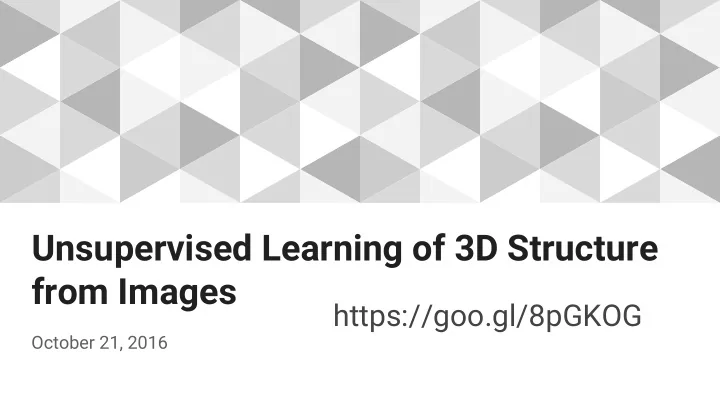

Unsupervised Learning of 3D Structure from Images https://goo.gl/8pGKOG October 21, 2016
Objective Find a statistical representation of data (images or volume data) that is generalizable to new unseen data (new views of an object). We want to infer a 3D representation (polyhedral mesh or dense volumes of voxels) from 2D images that we can render new instances of and reason about. Other approaches rely heavily on visual feature engineering, the paper’s approach is to learn to infer 3D representation directly from 2D images.
Applications 3D representations allows easier downstream properties of objects to use for: Physical reasoning of objects including interaction, and navigation, ● Scene completion, ● ● Denoising, ● Compression, and Generative virtual reality ●
Challenges 1. Inherently ill-posed: an infinite number of possible 3D structures to give rise to a particular 2D observation. Learn statistical models to find most likely representation ○ 2. Inference is intractable: mapping image pixels to 3D representations, handling multi-modality of representations 3. Unclear how to best represent 3D structures ○ Polyhedral mesh and dense volume of voxels are used in the paper
3D Representations Dense Volume Polyhedral of Voxels Mesh
Model
Conditional Generative Model Given observed volume or image x and a context c , infer 3D representation h , and render 2D image from either a Neural Net or OpenGL engine. Context c is either: nothing, object class label, or one or more views of a scene. The generative models with latent variables describe probability densities p( x ) though marginalization of the set of latent variables z . Bound Marginal likelihood p(x) by
Architectures Applied recent work on sequential generative models (similar to RNN) to capture complex distributions of 3D structures. Sequentially transform independent Gaussian latent variables into refinements of h (the “canvas”).
Architectures
Neural Framework
Results - Mesh
Results - Mesh
Results - Volume
Results - Volume
Conclusion The advantage of forcing inference into a specific format is that the NN can be chained together to perform various tasks.
Questions?
Recommend
More recommend